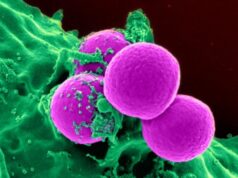Proper maternal folate levels during pregnancy may protect children from a future risk of obesity, especially those born to obese mothers, according to a study led by researchers funded by the National Institutes of Health.
“Maternal nutrition during pregnancy can have long-lasting effects on child health, as well as the health of a mother after pregnancy,” said the study’s principal investigator, Xiaobin Wang, M.D., M.P.H., Sc.D., from Johns Hopkins University, Baltimore. “Our results suggest that adequate maternal folate may mitigate the effect of a mother’s obesity on her child’s health.”
The study, published online in JAMA Pediatrics, was funded by NIH’s Eunice Kennedy Shriver National Institute of Child Health and Human Development (NICHD).
Obesity in children and adults is a serious health issue in the United States, contributing to such conditions as heart disease, stroke and type 2 diabetes. During pregnancy, maternal obesity also increases the risk for a range of pregnancy complications, such as stillbirth, birth defects and preterm birth. Furthermore, babies born to obese mothers have long-term health risks, including a higher risk of obesity in childhood.
Folate, an essential B vitamin, reduces the fetus’ risk for neural tube defects, which are malformations affecting the brain, spine and spinal cord. The U.S. Centers for Disease Control and Prevention recommends that women of childbearing age take 400 micrograms of folic acid (a synthetic form of folate) daily to reduce their children’s risk for neural tube defects. However, the role of maternal folate levels on a child’s future obesity risk was not known, especially among those born to mothers who are obese during pregnancy.
In their study, the researchers investigated the health outcomes of mothers and children (ranging from 2- to 9-years-old) in the Boston Birth Cohort, a predominately low-income, minority population with a high prevalence of maternal and child obesity. The study team analyzed health records from more than 1,500 mother-child pairs, including information that was collected before, during and after pregnancy. To gauge a mother’s folate level during pregnancy, the researchers measured folate from stored plasma samples that were collected two to three days after delivery.
Find your dream job in the space industry. Check our Space Job Board »
The study team found a wide range of maternal folate levels, but observed an “L-shaped” relationship between maternal folate levels and child obesity. In other words, the lowest levels of folate correlated with the highest risk of child obesity. When folate levels reached approximately 20 nanomoles per liter (nm/L), which is within the normal range for adults, further increases in folate levels did not confer additional benefits, indicating a threshold or ceiling effect.
According to the researchers, this threshold is higher than the standard cutoff for diagnosing folate deficiency (less than 10 nm/L).
Obese mothers in the study tended to have lower folate levels than normal weight mothers. However, when the researchers examined obese mothers only, they found that children of obese mothers with adequate folate levels (at least 20 nm/L) had a 43 percent lower risk of obesity compared to children of obese mothers with lower folate (less than 20 nm/L). The children in the latter group had higher body mass index-for-age z-scores (BMI-z)–a measure of body fat in children.
According to the authors, establishing an “optimal” rather than “minimal” folate concentration may be beneficial for women planning a pregnancy, especially obese women.
“Folate is well-known for preventing brain and spinal cord defects in a developing fetus, but its effects on metabolic disorders, such as diabetes and obesity, is less understood,” said Cuilin Zhang, M.D., Ph.D., NICHD senior investigator and a study co-author. “This study uncovers what may be an additional benefit of folate and identifies a possible strategy for reducing childhood obesity.”
Source: NIH/Eunice Kennedy Shriver National Institute of Child Health and Human Development
Journal: JAMA Pediatrics
Research Reference:
- Wang G, Hu FB, Mistry KB, Zhang C, Ren F, Huo Y, Paige D, Bartell T, Hong X, Caruso D, Ji Z, Chen Z, Ji Y, Pearson C, Ji H, Zuckerman B, Cheng TL, and Wang X. Associations of maternal prepregnancy BMI and plasma folate concentrations with child metabolic health. JAMA Pediatrics, June 2016 DOI: 10.1001/jamapediatrics.2016.0845










